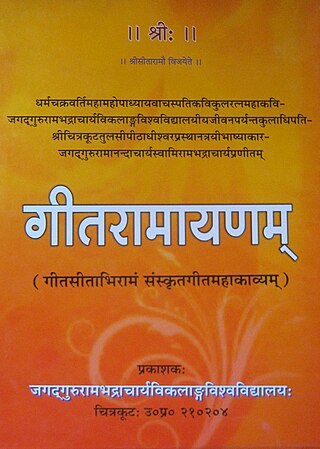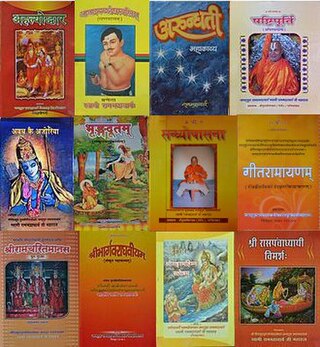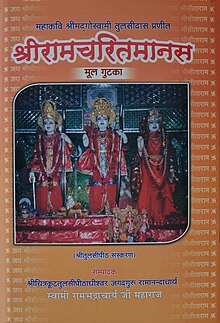
Rambola Dubey, known as Tulsidas, was a Vaishnava (Ramanandi) Hindu saint and poet, renowned for his devotion to the deity Rama. He wrote several popular works in Sanskrit, Awadhi, and Braj Bhasha, but is best known as the author of the Hanuman Chalisa and of the epic Ramcharitmanas, a retelling of the Sanskrit Ramayana, based on Rama's life, in the vernacular Awadhi language.
Jagadguru, literally meaning "guru of the universe", is a title used in Sanātana Dharma. Traditionally, it has been bestowed upon or used for ācāryas belonging to the Vedānta school who have written Sanskrit commentaries on the Prasthānatrayī – the Brahma sūtras, the Bhagavad-gītā and the principal Upaniṣads. Historically, jagadgurus have established a lineage and an institution to spread dharma which has been based in Varanasi, the centre of Sanskrit study.

The Hanuman Chalisa is a Hindu devotional hymn (stotra) in praise of Hanuman, and popularly recited by millions of Hindus everyday. It is an Awadhi language text attributed to Tulsidas, and is his best known text apart from the Ramcharitmanas. The word 'chālīsā' is derived from 'chālīs' meaning the number 'forty' in Hindi, denoting the number of verses in the Hanuman Chalisa.

Arundhati is the wife of the sage Vasishtha, one of the seven sages (Saptarshi) of Hinduism.

Jagadguru Ramanandacharya Swami Rambhadracharya is an Indian Hindu spiritual leader, educator, Sanskrit scholar, polyglot, poet, author, textual commentator, philosopher, composer, singer, playwright and Katha artist based in Chitrakoot, India. He is one of four incumbent Jagadguru Ramanandacharya, and has held this title since 1988.

Gītarāmāyaṇam (2011), literally The Rāmāyaṇa in songs, is a Sanskrit epic poem (Mahākāvya) of the Gītakāvya genre, composed by Jagadguru Rambhadracharya (1950–) in the years 2009 and 2010. It consists of 1008 songs in Sanskrit which are divided into seven Kāṇḍas (books), every Kāṇḍa being sub-divided into one or more Sargas (cantos). There are 28 cantos in all, and each canto consists of 36 songs. The songs of the epic are based on rhythms and tunes or Rāgas found in the folk music and classical music of India. In the epic, each song in sung by one or more characters of the Rāmāyaṇa or by the poet. The songs progressively narrate the Rāmāyaṇa via monologues, dialogues and multilogues. There are occasional Sanskrit verses between the songs, which take the narrative forward.

Arundhatī (1994) is a Hindi epic poem (Mahakavya) composed by Jagadguru Rambhadracharya (1950–) in the year 1994. It consists of 1279 verses in 15 cantos (sargas). The poem presents the narrative of the couple Arundhatī and Vasiṣṭha which is found in various Hindu scriptures. As per the poet, the narration of the epic is directly related to the psychological evolution of humans. A copy of the epic was published in 1994 by the Shri Raghav Sahitya Prakashan Nidhi, Haridwar, Uttar Pradesh. The book was released by the then President of India, Shankar Dayal Sharma on July 7, 1994.

Jagadguru Rambhadracharya Divyanga University (JRDU), formerly Jagadguru Rambhadracharya Handicapped University, is a public UP state government university in Chitrakoot, Uttar Pradesh. It was established in 2001 by Jagadguru Rambhadracharya for disabled people .Jagadguru Rambhadracharya in 2022 wishes to make this University as a UP state government, he suggested UP CM Yogi Adityanath ji to takeover this University as State Public University, in June 2023 Uttar Pradesh government accorded status of State government university by passing Law in UP State assembly i.e.The Uttar Pradesh Jagadguru Rambhadracharya Divyang State University. Act, 2023 under Department of Divyangjan under which 50 percent of Divyang students and 50 percent other students can took addmission at this University .It was the only university in the world exclusively for disabled people until the establishment of Dr. Shakuntala Misra National Rehabilitation University at Lucknow.
Tulsi Peeth Seva Nyas is an Indian religious and social service institution based at Janki Kund, Chitrakoot, Madhya Pradesh, India. It was established by the Hindu religious leader Jagadguru Rambhadracharya on August 2, 1987. Rambhadracharya believes that this Peeth is situated at the place where the Hindu god Rama gave his sandals to his brother Bharat.

Jagadguru Rambhadracharya is a Hindu religious leader, Sanskrit scholar and Katha artist based in Chitrakoot, India. His works consist of poems, commentaries, plays and musical compositions of his works, etc. He has authored more than 250 books and 50 papers, including four epic poems, a Hindi commentary on Tulsidas' Ramcharitmanas, and Sanskrit commentaries on the Ashtadhyayi and the Prasthanatrayi scriptures. Various audio and video recordings o his works have also been released. He writes in Sanskrit, Hindi, Awadhi, Maithili, and several other languages.

This timeline lists important events relevant to the life of the Vaishnava (Hindu) spiritual leader, poet, commentator, educationist, religious and social figure Rambhadracharya.
Śrīrāghavakṛpābhāṣyam is a series of Sanskrit commentaries on the Prasthanatrayi, authored by Rambhadracharya. These commentaries were released on 10 April 1998 by the then Prime Minister of India, Atal Bihari Vajpayee. Rambhadracharya composed a commentary on Narada Bhakti Sutra in 1991, and thus revived the tradition of Sanskrit commentaries on the Prasthanatrayi after five hundred years. This was also the second commentary of the Ramananda Sampradaya on Prasthanatrayi, the first being the Ānandabhāṣyam, composed by Ramananda himself. These commentaries were published by Shri Tulsi Peeth Seva Nyas. The author won the Rajshekhar Samman from the Madhya Pradesh Sanskrit Academy, Bhopal, for the commentaries.

Jagadguru Ramanandacharya Swami Rambhadracharya is a Hindu religious leader, Sanskrit scholar and Katha artist based in Chitrakoot, India. Rambhadracharya is a spontaneous poet and writer in Sanskrit, Hindi, Awadhi, Maithili, and several other languages. He has authored more than 100 books and 50 papers, including four epic poems, a Hindi commentary on Tulsidas' Ramcharitmanas, a Sanskrit commentary in verse on the Ashtadhyayi, and Sanskrit commentaries on the Prasthanatrayi scriptures. He is regarded as one of the greatest authorities on Tulsidas in India, and is the editor of a critical edition of the Ramcharitmanas.

Swami Vishwadevanand Puri was a Hindu monk and a traditional teacher of Advaita Vedanta. He founded the Vishwakalyan Foundation Trust in Haridwar.
Tulsi Manas Mandir is one of the most famous temples in the holy city of Varanasi. This temple has great historical and cultural importance in Hinduism since the ancient Hindu epic Ramcharitmanas was originally written at this place by Hindu poet-saint, reformer and philosopher Goswami Tulsidas in the 16th century.

Yajnavalkya Ashram was a gurukul of the Indian philosopher Yajnavalkya. It is believed that Yajnavalkya got his enlightenment here. It is the place where he wrote many texts of Ancient Indian philosophy. He wrote Shatapatha Brahman, Yajnavalkya Smriti, Brihadaranyaka Upanishad, Yoga Yajnavalkya and many more. Yajnavalkya Ashram is situated at Jagban village of Madhubani district in Mithila region of Bihar.
Ashtavakra Mandir is the Hindu temple built in the memory of the Indian philosopher Ashtavakra at the bank of the holy river Ganga near Kahalgaon,Bihar. The temple was inaugurated by Padmavibhushan Swami Rambhadracharya. The temple is located at Charon Dham Ghat of Uttar Vahini Ganga Ghat in Kahalgaon of Bhagalpur district. Kahalgaon is believed as the birthplace of the Indian philosopher Ashtavakra. It is the first temple devoted to Ashtavakra.













